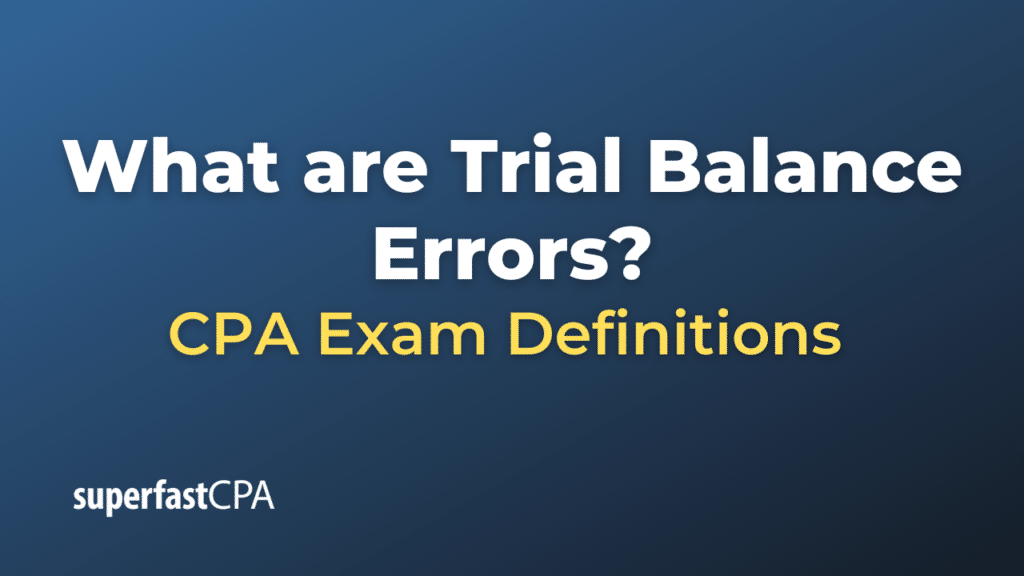Trial Balance Errors
Trial balance errors refer to mistakes that can occur during the process of recording transactions and balances in ledgers and, subsequently, presenting them in a trial balance. If the sum of debits doesn’t equal the sum of credits in a trial balance, there’s likely an error somewhere.
Here are some common types of trial balance errors:
- Transposition Errors: This occurs when two digits are reversed. For instance, writing $63 as $36 or vice versa.
- Slide Errors: This happens when the decimal point is misplaced. For example, recording $1,000 as $100 or $10,000.
- Omission: Forgetting to record a transaction altogether.
- Duplication: Recording a transaction more than once.
- Recording in the Wrong Account: Posting a transaction to an incorrect account, e.g., debiting rent expense instead of utilities expense.
- Error of Original Entry: Recording the wrong initial amount for a transaction, such as writing down $150 instead of $105.
- Error of Principle: Posting a transaction in violation of accounting principles. For instance, treating a capital expenditure as a revenue expenditure.
- Compensating Errors: Two or more errors that happen to cancel each other out, so the trial balance still appears correct even though it contains mistakes. For example, if you mistakenly under-debit one account by $100 and over-debit another account by the same amount, the errors compensate for each other.
- Incomplete Recording: Only one aspect of a dual-entry transaction is recorded. For instance, if a business buys supplies on credit and records the supplies as an asset but forgets to record the corresponding accounts payable.
- Errors of Commission: This occurs when the correct amount is entered in the right type of account but the wrong specific account. For example, crediting the payment to the wrong supplier’s account.
- Balancing Errors : When an account is balanced incorrectly and the wrong balance is taken to the trial balance.
- Error in the Trial Balance Itself : Sometimes, the error may not be in the ledgers but in the process of preparing the trial balance. For instance, figures might be taken down incorrectly, or certain accounts might be accidentally omitted.
Identifying and correcting these errors is crucial for accurate financial reporting. Some errors, like compensating errors or errors of principle, won’t necessarily be flagged by a mismatched trial balance, which is why careful review and periodic reconciliation processes are essential in accounting.
Example of Trial Balance Errors
Let’s explore a few of the trial balance errors mentioned above with examples:
- Transposition Error:
- Bella’s Boutique recorded a sale of $541 but mistakenly entered it as $451 in the sales account. This would create a difference of $90 in the trial balance.
- Slide Error:
- Bella’s Boutique recorded a piece of equipment worth $10,000 but mistakenly entered it as $1,000 in the equipment account. This would create a difference of $9,000.
- Omission:
- Bella’s Boutique paid $2,000 for rent but forgot to record this transaction. Thus, both the bank (or cash) and the rent expense would be understated by $2,000 in the trial balance.
- Duplication:
- Bella’s Boutique bought inventory worth $3,000 and accidentally recorded the transaction twice. This would overstate both inventory and accounts payable (or cash/bank if it was a cash purchase) by $3,000.
- Recording in the Wrong Account:
- Bella paid $1,200 for an insurance policy and mistakenly debited it to rent expense. Here, the insurance expense is understated by $1,200, and the rent expense is overstated by the same amount.
- Compensating Errors:
- Bella’s Boutique under-debited the salary account by $500 and over-debited the utilities account by $500. Though the trial balance may match, the individual accounts have incorrect balances.
- Incomplete Recording:
- Bella’s Boutique sold products worth $4,000 on credit but only recorded the accounts receivable without recording the sales revenue. This would lead to an understatement of sales by $4,000.
- Errors of Commission:
- Bella owed Smith Suppliers $2,500 and mistakenly paid and recorded this amount to Jones Suppliers, another creditor. While the total creditors remain correct, the individual supplier accounts are inaccurate.
By walking through these specific examples, it’s evident that the process of identifying and correcting trial balance errors requires a keen eye for detail, a comprehensive understanding of accounting principles, and sometimes detective work to trace back to the original transactions.













